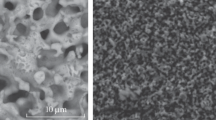Abstract
To establish the patterns of the wettability of solid surfaces by ionic melts, the wetting energy of a gold electrode by lithium, sodium, potassium, and cesium chloride melts was studied as a function of the electrical potential applied to the electrode. It was established that when the potential was shifted in the positive direction relative to the zero-charge potential of gold in the corresponding melt, the shape of the curve that defined the dependence of the wetting energy on the electrical potential varied according to the salt composition: for lithium and sodium chlorides, the wetting energy increased monotonically, while in potassium and cesium chloride melts there was a maxima. This phenomenon was explained from the standpoint of the mutual polarization of gold and chlorine ions in the place of their direct contact. At a certain electric field strength in the double electric layer and at a certain binding energy of the melt particles, the resultant mutual ion polarization led to the formation of ordered layers of ionic associations (presumably AuCln(n − 1)-) on the anode surface, which shielded the electrode charge.





Similar content being viewed by others
References
(2013) Molten Salts Chemistry. In: Lantelme F, Groult H (eds) From lab to applications, Elsevier, Amsterdam, 354 p
Adamson AW (1990) Physical chemistry of surfaces, 5th edn. Wiley, New York
De Gennes PG (1985) Wetting: statics and dynamics. Rev Mod Phys 57:827–863
Vogt H (1999) The anode effect as a fluid dynamic problem. J Appl Electrochem 29:137–145
Meunier P, Welch B, Skillas-Kasacos M, Sahajwalla V (2009) Effect of dopands on wetting properties and electrochemical behaviour of graphite anodes in molten Al2O3-cryolite melts. J Appl Electrochem 39:837–847
Frolov AV, Gusev AO, Shurov NI, Kulik NP, Sitnikov LV, Babushkina LM, Stepanov VP, Zaykov YP, Khramov AP, Malkov VB (2006) Wetting and cryolite bath penetration in graphitized cathode materials. Light metals TMS (The Minerals, Metals & Materials Soc):645–649
Baumli P, Kaptay G (2008) Wettability of carbon surfaces by pure molten alkali chlorides and their penetration into a porous graphite substrate. Mater Sci Eng A 495:192–196
Kavase M, Mugikura Y, Watanabe T (2000) An electrolyte distribution model in consideration of the electrode wetting in molten carbonate fuel cell. J Electrochem Soc 147:854–860
Altomare M, Truong NN, Schmuki P (2016) Templated dewetting: designing entirely self-organized platforms for photocatalysis. Chem Sci 7:6865–6886
Mugele F, Baret J-C (2005) Electrowetting: from basics to applications. J Phys Condens Matter 17:R705–R774
Stepanov VP, Yakshevich IV, Belyaev VS (2000) Adsorption activity of Cu, Au and Ni solid electrodes in molten carbonates. Z Phys Chem 214:359–377
Puddephatt RJ (1978) The chemistry of gold. Elsevier Scientific, Amsterdam
Warren RW (1965) Procedures and apparatus for zone purification of the alkali halides. Rev Sci Instrum 36:731–737
Smirnov MV, Aleksandrov KA, Khokhlov VA (1977) Diffusion potentials and transport number in molten alkali chlorides and their binary mixtures. Electrochim Acta 22:543–550
Smirnov MV, Stepanov VP (1979) Zero-point potential of metals in molten alkali halides and their binary mixtures. Electrochim Acta 24:651–655
Bukun NG, Alekseeva RA (1975) The double layer capacity of gold in a chloride melt. Elektrokhimiya (in Russian) 11:1738–1741
Lockett V, Sedev R, Ralston J, Rodopoulos T, Horne M (2008) Differential capacitance of the electrical double layer in imidazolium-based ionic liquids: influence of potential, cation size, and temperature. J Phys Chem 112:7486–7495
Lockett V, Horne M, Sedev R, Rodopoulos T, Ralston J (2010) Differential capacitance of the double layer at the electrode/ionic liquids interfaces. Phys Chem Chem Phys 12:12499–12512
Kirillova EV, Dokashenko SI, Stepanov VP (2008) The capacity and the impedance of the interface between the polycrystalline gold and alkali chloride melts. Rasplavy (in Russian) 4:74–79
Kirillova EV, Stepanov VP (2016) Capacitance of the double electrical layer on the copper-group metals in molten alkali metal halides. Russian Metallurgy (Metally) 2016(8):691–697
Pastukhov YG, Stepanov VP (1989) The study of a gold electrode in molten potassium halides by the estance method. Doklady Akademii Nauk SSSR (in Russian) 307:648–652
Tazi S, Salanne M, Simon C, Turq P, Pounds M, Madden PA (2010) Potential-induced ordering transition of the adsorbed layer at the ionic liquid / electrified metal interface. J Phys Chem B 114:8453–8459
Melendres CA, Hahn F (1999) In situ observation of halide ion adsorption on a gold electrode using synchrotron far infrared spectroscopy. J Electroanal Chem 463:258–261
Loo BH (1982) In situ identification of halide complexes on gold electrode by surface-enhanced Raman spectroscopy. J Phys Chem 86:433437
Sitnikov LV, Zakir’yanova ID, Ev K (2016) Study of the chlorine anion interaction with surface of the gold electrode by GRS spectroscopy under electric polarization. Rasplavy (Melts) (in Russian) 5:455–463
Liu XJ, Moritomo Y, Nakamura A, Kojima N (1999) Pressure-induced phase transition in mixed-valence gold complexes Cs2Au2X6 (X=Cl and Br). J Chem Phys 110:9174–9178
Saltykova NA, Pecherskaya LS, Baraboshkin AN, Kotovsky SN, Kosikhin LT (1986) Salt passivation during anodic dissolution of iridium chloride melts. Elektrokhimiya (in Russian) 22:579–584
Salyulev AB, Vovkotrub EG (2014) Investigation of the chlorination products of palladium in the presence of alkali and alkaline earth chlorides by Raman spectroscopy. Problemy spektroskopii I spektrometrii (in Russian) 33:99–105
Acknowledgements
The authors would like to thank Vovkotrub E.G, PhD for performing the Raman analyses of samples using the facilities in the shared access center “Composition of compounds” IHTE, UB RAS.
Funding
This work was partially funded by programs of the Ural Branch of the RAS (project 18-5-3-12).
Author information
Authors and Affiliations
Corresponding author
Rights and permissions
About this article
Cite this article
Stepanov, V.P., Kirillova, E.V. Polarization and adsorption effects on the wettability of a gold electrode by lithium, sodium, potassium, and cesium chloride melts. Ionics 25, 2763–2768 (2019). https://doi.org/10.1007/s11581-018-2755-4
Received:
Revised:
Accepted:
Published:
Issue Date:
DOI: https://doi.org/10.1007/s11581-018-2755-4




